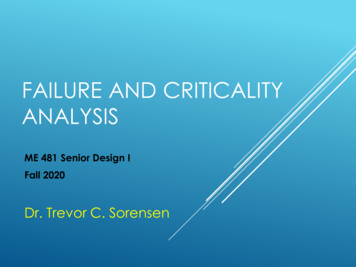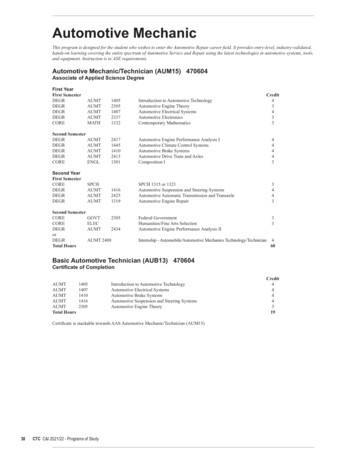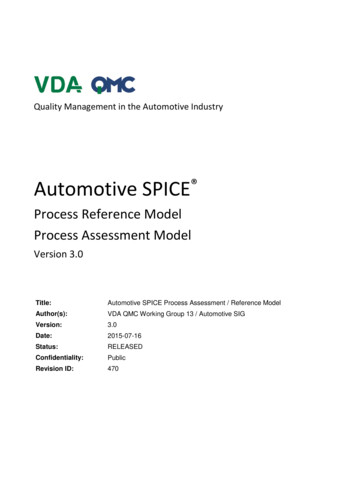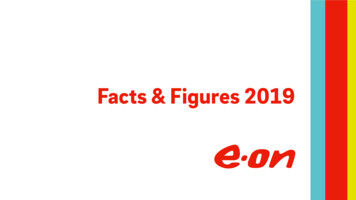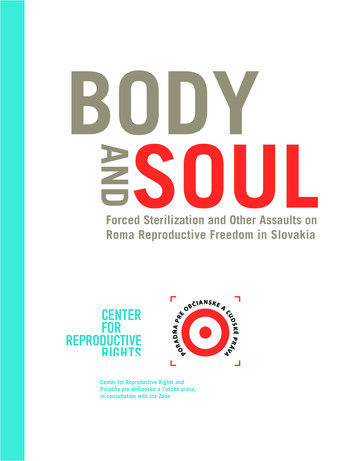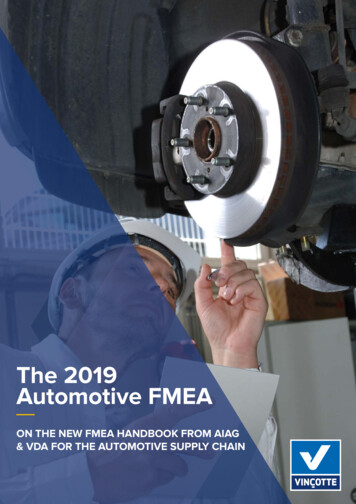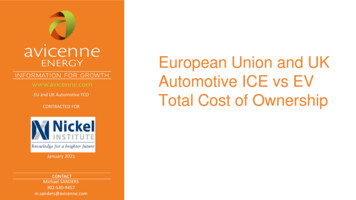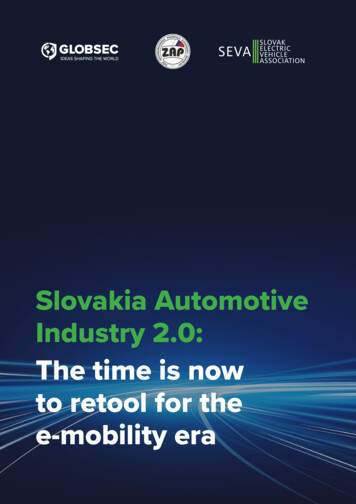
Transcription
Slovakia AutomotiveIndustry 2.0:The time is nowto retool for thee-mobility era
AutoFocus Slovakia is a GLOBSEC initiative fundedby the European Climate Foundation. The aim is tosupport a long-term national strategy for Slovakia’sautomotive transformation from ICE to EV production that is commensurate and competitive with theVisegrad 4. The findings and messaging for Slovakia are relevant for the wider Central and EasternEurope (CEE) region forming Europe’s automotivemanufacturing ‘backbone’ that face similar challenges. The aim is to encourage a ‘race to the top’to provide the conditions for attracting EV and battery investment, which includes improved domestice-mobility perceptions and capabilities. The studycould also serve as a model for the green industrialtransformation in other sectors which should benefitfrom policy spillover and best practices.GLOBSEC has hosted several stakeholder meetingssince the initiative was launched in the fall of 2020,with leading voices from Slovak academia, industry,and government, both on and off the record. Thiswas made possible with support from ZAP (Automotive Industry Association of the Slovak Republic) Slovak Battery Alliance (SBaA), Slovak Electric VehicleAssociation (SEVA), the German-Slovak Chamberof Commerce, and the French-Slovak Chamber ofCommerce.Authors:Cambridge Econometrics performed the macro-economic modelling underpinning the report using theE3ME model. Scenarios, assumptions, and preliminary outcomes were further developed and refinedover a three-month stakeholder consultation process with industry representatives in the fall of 2021.Federica Prandin, GLOBSECIt is worth specifying that the modelling analysisand outcomes only factor in the potential for EVand battery production relative to the manufacturing of combustion powertrain vehicles - which itselfrequires multiple layers of data and assumptions.There are several additional e-mobility sub-sectorswith growth potential that can have a positive employment substitution effect, from the constructionof physical charging infrastructure to the development of digital software and AI.Cornelia-Madalina Suta, Cambridge EconometricsNolan Theisen, GLOBSECJanos Hidi, Cambridge EconometricsJamie Pirie, Cambridge EconometricsLuca Barbieri, Cambridge EconometricsZsófi Kőműves, Cambridge EconometricsSlavomir Hubatka, Kosice Technical University(TUKE)Patrik Križanský, Slovak Electric VehicleAssociation (SEVA)
PrefaceThe Slovak industrialization success story can belargely attributed to the growth in the automotivemanufacturing sector over the past thirty years, beginning with Volkswagen’s (VW) Bratislava plant inthe early 90s, followed by Peugeot Citroën (PSA),Kia, and Jaguar Land Rover (JLR) in the decadesthat followed. We are now approaching the middleof another decade unlike any other for the industry,when seeds of EV and battery production are beingsown, and the window is closing fast. For a substantial EV uptake by 2030, investment decisions needto be made by 2023 and are expected even thisyear.In addition to that, the current decade is shakingand shaping the automotive sector, and the international community more broadly, with two unprecedented shocks: the Covid-19 pandemic (2020-2022)and the more recent Russian aggression in Ukraine.The former has presented the industry with adaptation challenges linked to fostered digital and greentransitions while upending international supplychains, with consequent trade and production pressures. The war in Ukraine further exacerbated thissituation, adding to the huge shortage of semiconductor chips, which already in 2021 cut the automotive industry’s output by 8 million vehicles globally.1According to preliminary estimates, the conflict isexpected to cause global vehicle production to dropby 1.5 million this year, that is 2% less than the 84million vehicles planned.2Further disruptions are expected in both global EVbattery cell and combustion engine vehicle manufacturing due to the shortage of crucial raw materials mined in Russia and Ukraine. Notably, Russia extracts 40% of the world’s palladium, used in catalyticconverters in gasoline-powered vehicles.3 Additionally, concerns over European energy security haveintensified due to its structural dependence on Russia’s fossil fuels, with energy prices reaching recordhighs and fear of disruptions in gas, oil, and coalsupplies.4 Against this background, the development of domestic battery ecosystems would benefitSlovakia in three key ways, by: 1) reducing asymmetrical trade dependencies 2) transforming the country into an innovation hub within the EU, and 3) offsetting the losses from the ICE vehicle supply chaindismissal.1234“Slovak economy isheavily dependenton car manufacturing.With the fasttransition frominternal combustionengine to electricvehicles, Slovakiahas to transform andadjust to the newsituation. The studypresents a clear andthoughtful roadmapfor such challengingtransformation.”Vazil HudákVice-Chairman. GLOBSECHyunjoo J., “Automakers, chip firms differ on when semiconductor shortage will abate”, Reuters, February4, 2022, r-shortage-will-abate-2022-02-04/Rhodes, B., et al., “Major revision for global light vehicle production forecast – what it means for OEMs’ technology deployment”07 October 2021, -w.html?ite 1001653&ito 1276&itq fc9ec941-075f-4aa9-a106-eaedc2ae6e2f&itx%5Bidio%5D 775416589Pakiam, R. “Markets Wild Palladium Rally at Risk From Recession Later This Year”, Bloomberg, later-this-yearAl-Jazeera, “Europe’s energy security worries NATO amid standoff with Russia”, January 30, 2022, pe-energy-security-ukraine-russia
The transition towards zero emission vehicles, andespecially to battery electric cars (BEV) has been accelerating during 2020-2021. Regulators around theglobe have been introducing strategies to switchfrom internal combustion engine (ICE) to electric vehicles (EVs) as part of the overall efforts towards amore sustainable world. 74% of Slovakia’s key export markets have already announced bans on ICEvehicles sales by 2035.5 The country’s strong reliance on car manufacturing makes it particularly vulnerable to EV adoption trends. Domestic producerswill have to adapt to the changing market situation,regardless of the local rate of the EV take-up, if theyare to remain competitive.This is a wake-up call for Slovakia to get behinde-mobility with implementable plans and concreteactions. A coherent strategy requires leadershipand must be driven by inter-ministerial coordination, based on a common framework of understanding and acceptance that EVs uptake is inevitable,and those who do not adapt will be left behind. Ifthe government does not demonstrate to OEMs andother prospective investors that they mean business for e-mobility, not only as the future of the industry but as part of Slovakia’s smart and sustainable transport, JLR could be the last such greenfieldinvestment in the sector. Everyone expects realsteps in the use of BEVs and the development of anappropriate charging infrastructure, which must follow the principles of Alternative Fuels InfrastructureRegulation (AFIR).This report presents the results of a research onthe impacts of the transition from ICE to EVs on Slovakia’s GDP and employment outlook. The studyforesight scenarios that highlight the potential benefits and risks associated with this process, providing policymakers with recommendations on how tocope with the transformative wave in the automotive sector. Against this background, this researchaims to support Slovakia in facing the greatest challenge to transform its economic anchor and nationalidentity – the passenger vehicle – to meet the global mobility demands of the future. The study alsoseeks to become a case study for green industrialtransitions across the EU.which should go hand in hand with R&D prioritization and funding.Slovakia is competing, especially with its neighbors,to grab a share of the 500 GW EU battery pie expected to be worth EUR 50 billion later this decade.Losses in the internal combustion powertrain supplychains could only be compensated for by developing a battery industry.This report is divided into four interrelated sections:1.Context and indicators providing an industryoverview and V4 trends;2.Economic impact highlighting 2035 employment and GDP modelled outcomes;3.Policy recommendations to overcome persistent challenges slowing investment andinnovation;4.Methodology for the modelling.Making the leap to e-mobility requires governmentcommitment and collective public buy-in whichwe hope to further justify and build upon with thelaunch of this report and subsequent engagements.Signed,Vazil Hudák, Alexander Matušek and PatrikKrižanskýThe green transition offers Slovakia the opportunity to become a leader in EVs production. Buildingon this opportunity, Slovakia’s automotive industrywould modernize with positive effects on GDP andemployment. For this to happen, the labour market needs to be prepared to meet the demands ofe-mobility specializations, which is already at a deficit. Beyond electric, the future of mobility is smart,which will demand significant new and upgradedinfrastructure underpinned by IT company services.All of this requires proper training and education,5Cambridge Econometrics,” Electromobility in the Visegrad region – Slovakia”, January 2022.
Context and IndicatorsSlovakia’s automotive landscapeSource: SARIO (internal documentation)Today Slovakia is the leading car producer per capita in the world, owing to four world-class automotivecompanies (Big 4) opening their factories: Volkswagen Slovakia in Bratislava (since 1991), PSA PeugeotCitroën Slovakia in Trnava (since 2003), Kia MotorsSlovakia in Žilina (since 2004) and Jaguar Land Rover in Nitra (since 2015).Slovakia deeply identifies with its automotive tradition as the sector has grown to become the drivingforce of the economy. Car manufacturing is the largest industry in the country, constituting 13% of GDP,54% of industrial production (compared to 33% inHungary 31% in Czechia), 33% of industrial exportsand 10% of the employed population (approximately 275,000 jobs between Tier 1 (177,000) and Tier 2and services 98,000).6There are more than 350 automotive suppliers inSlovakia accounting for the vast majority (89%) of direct jobs across the industry. The large Tier 1 foreignaffiliates account for most of the value added in thesector compared to Tier 2 suppliers, which are typically Slovak small and medium-sized enterprises(SMEs).6Among the Visegrad 4, Slovakia is the least diversified in terms of its production portfolio with onlyone plant producing engines and all four factoriesdedicated to passenger vehicles. Comparatively,Polish manufacturing focuses on buses and engineswith two of its 16 plants producing passenger vehicles. Czechia mainly produces passenger cars andengines, although some companies focus on buses and heavy duty vehicles manufacturing. Hungary produces passenger cars, engines and buses.1Nonetheless, Slovakia is currently among the topEuropean producers of electric cars (75,575) behindonly Germany and France.With EVs constituting 70% less parts than ICE vehicles, robotization and Industry 4.0, the transformation of the automotive industry will significantly impact the current workforce, creating distributionalemployment effects throughout regions and communities depending on the car component and thecompany’s willingness and ability to adapt.This study shows how urgent it is for Slovakia to invest in innovative projects that would foster batteryand EV production. Historical data further supportthis conclusion. As the graph below illustrates, in2019, public and private R&D investment in Slova-Hubatka S., “Slovakia: An Automotive Industry Perspective”, GLOBSEC, July 2021, tive.pdf
kia amounted to 0.83% of GDP, of which only 0.01% went to energy and environmental R&D. These figures arewell below the EU average and the lowest among the V4, as shown in the chart below:The lack of resources for innovation is also reflected in the low number of patents per million inhabitants inSlovakia, which scores last among the Visegrad4, all far below the EU average:Gross Domestic Expenditure on R&D as percentage of GDP, V4 and EU-28Source: Eurostat (eurostat/data)The chart below shows that the Visegrad 4 labour productivity in the automotive manufacturing sector is abouthalf the EU average. Among V4, Hungary and Czechia are the most productive, Poland the lowest, and Slovakia ranks average. While cars are traditionally manufactured in Slovakia, the development of new conceptsand innovative products mostly happens in the parent company headquarters.7 Investments need to no longertarget the assembly line only, but upskilling, reskilling, and R&D, in the country.8Patent applications to the European Patent Office, per million inhabitants, V4 and EU-28Source: Eurostat sights collected during stakeholders consultations.
V4 Labour Productivity in the Manufacturing of Motor, Vehicles, Trailers and Semi-trailers,gross value added per employee (thousands of Euro) 2010-2017Source: Polish Economic Institute -Raport Automotive.pdf)
Economic ImpactThe global transition from the internal combustionengine (ICE) to electric vehicles (EVs) will inevitablyaffect Slovakia’s key export markets, 74% of whichhave announced bans on ICE vehicles sales by2035.This study evaluates the economic impacts of increasing EV demand from such export markets. Theassessment builds upon two scenarios: a worstcase or business-as-usual scenario in which theswitch to EV production does not take place, losingthe majority of its ICE market share, and a best-casescenario under which Slovakia adapts its vehiclemanufacturing sector to external trends in EVs uptake.Results show that the stakes are high for Slovakia.In the worst-case/business-as-as usual scenario, national GDP will be 10% lower than in the best-casescenario.The overall net employment effect is also significant, with a 4% difference between the two scenarios. While the worst-case is expected to bring a 4.5%job loss, in the best-case total employment will dropby 0.3%. At the same time, the best-case scenariowill see a net increase of 18%, or 8,000, jobs in theelectrical equipment sector. Slovakia will still needto develop its own domestic battery production capacity, rather than relying on import, to capture value added.Notably, among occupations, the gainers of thetransition to EVs would be technical occupationssuch as engineering professionals and software developers. Assemblers, which constitutes the bulk ofthe workforce in the two sectors, might experiencethe sharpest drop in employment, except in the scenario in which 100% of batteries are produced domestically. The influx of workforce from Ukraine,Russia and EU neighborhood countries might havea positive effect on the uptake of highly skilled tasksand related expertise transfer. Despite so far onlywomen and children have been able to resettle –with 220,977 of Ukrainians being accepted in Slovakia since the beginning of the conflict10 – nce theconflict will be over, men will likely reunite with theirfamily amidst challenging reconstruction in Ukraine.Previous research shows that the structure of laborforce from Ukraine is dominated by well-educatedand highly skilled individuals, who are also culturally close to the Slovak population and well adaptableto a host society.11 Such migration flows would compensate the massive migration loss of Eastern Slovakia, mitigating its negative consequences, including loss of human capital.12The graph below visualizes the above-mentioneddata:GDP and Employment Impact in central scenariosSource: Cambridge Econometrics99101112For more information about this model and the related assumptions, consult section (VI) on methodology.UNHR, Operational Data Portal, ný, L., et al., “International migration to an economically lagging EU region: case study of Ukraine and Eastern Slovakia”, Geographia Cassoviensis, January 2020, https://www.researchgate.net/publication/348195496 International migration to an economically lagging EU region case study of Ukraine and Eastern SlovakiaIbid.
The net impact of the transition to EV production is sensitive to whether Slovakia will secure enough domestic battery production capacity to meet EVs demand from its export markets. The COVID-19 crisis before andthe Russian war in Ukraine now remind us about the risks of supply chain disruptions and the need to pursuea dual-strategy of supply diversification and domestic production. Should Slovakia be able to secure such production, employment and economic losses from the ICE vehicle supply chain would be offset. However, thiswould require Slovakia ensuring substantially more battery production than the one currently planned.If Slovakia was to follow the best-case scenario and transition from ICE to EV vehicle production, substantialinvestments would be needed to 1) build new EVs or retrofit existing ICE production facilities and 2) producebatteries to meet EV production requirements. Results show that:1) The required total investment in EV production facilities should be 3.4bn by 2040. The estimationis broken down for select year in Table 32.Table 32: Calculation of investment in EV production facilities2025203020352040EV Share of exports10%60%95%100%Additional EV share of exports (compared to 2020)4%54%89%93%Vehicle production1,000,0001,000,0001,000,0001,000,000EVs produced43,287536,740889,079932,121EV production investment per annual vehicle productioncapacity ( m/vehicle)0.00360.00360.00360.0036EV Production Cumulative investments ( m)157195232333390Source: Cambridge Econometrics2) Slovakia would need 65 GWh of batteries annually to be able produce all the EVs in the best-casescenario, which means 5.6bn of investment, as detailed in the table below:Table 33: Calculation of investment in EV battery production capacity2025203020352040Additional EV share of exports4%54%89%93%Vehicle production1,000,0001,000,0001,000,0001,000,000EVs produced43,287536,740889,079932,121Battery size (kWh)70707070Total battery requirements (GWH)3386265Cost of investment per GWH capacity ( m perGWH)85858586Cumulative investments ( m)2583,1945,2905,611Source: Cambridge Econometrics
Policy RecommendationsKey tasks for the governmentLack of innovations in Slovakia is largely connectedto failure at attracting enough investment. Despitethis has been acknowledged by both the private andpublic sectors, substantial changes have not beenimplemented yet. In addition, Slovakia was one ofthe poorest performers in EU fund absorption in the2014-2020 period (38%).In the upcoming 2021-2027 period, Slovakia will haveEUR 12.8 billion in grants at its disposal, supportingthree priority areas – Innovative Slovakia, EcologicalSlovakia for Future generations, and Mobility, transport, and connectivity (see detailed chart in Annex 1).All of these are connected to the automotive transformation and should overlap and reinforce the twingreen and digital agendas of the Recovery and Resiliency Facility (RRF), from which more than EUR 600million will go towards innovations.New and specific skills are needed across the e-mobility value chain, specializing in areas such as highvoltage operating systems, data network risk management, and AI, among others. This requires notonly reskilling and upskilling where applicable, buta wholesale reform of the university education system.The following policy recommendations are meantto support the government effort to forge a path forSlovakia’s automotive transformation. Their uptakewould improve the business environment, facilitatetalent and innovations development, with positivespillover effects for unlocking the green and digitaltransformations across economic sectors and industries: Improve general business conditionsImprove general business conditions especiallyespecially for green projects by speeding upfor green projects by speeding up thethe administrative process and cutting redadministrative process and cutting red tapetape Clarifyand supporteligibilityof greenprojects Clarifyand supporteligibilityof greenprojectsfor EUto leveragerisk capitalforfinancingEU financingto leveragerisk capital IntegrateEU fundsEuropeanInvestmentIntegrateEU fundswith ldingBank (EIB), Slovak Investment Holding (SIH)(SIH)andand commercialloans in consultationwithcommercialloans in consultationwith businessbusinessesthat will use themes thatwill use them PreparePreparepotentialgreenfieldsites(in termspotentialgreenfieldsites(in termsof ofownership,changeofuseetc.)ownership, change of use etc.) throughwithambitioustax taxreform FollowFollowthroughwithambitiousreform pleprinciplethatthatwaswasdelayeddelayedby COVID-19by COVID-19 Foster collaboration between tech universities Foster collaboration between tech universitiesand industry and within the wider RDI ecosysand industry and within the wider RDI ecosystem in the regiontem in the region Strengthen international university exchanges andStrengtheninternationaluniversityexchanges andcollaborationbetween regionalresearchcollaboration between regional research institutesinstitutes dualeducationandandcreatingnewnewin de UsingUsingdualeducationcreatinginmandmajorsat universitiesdemandmajorsat universities a strategyfor for‘braindrainto brain DevelopDevelopa strategy‘braindrainto brain gain’ ingain’incooperationwithuniversitiesthat re- structurcooperation with universities that removesmovesstructuralbarriersto the JustFundTransitional barriersto theJust Transition(JTF)Fund (JTF)Furthermore, given its unique experience and currentposition at the heart of the global automotive supplychain, Slovakia should also: Appeal to VW and other car manufacturers to cooperateAppeal into R&D,VW andother carmanufacturers tofocusingon rautonomy, decision-making powersand aautonomy,decision-makingpowersand asingular grant agency (following the l) through which companies can e, research and development , i.e. Center for Research and Developgrants,i.e.BatteriesCenter forandwithDevelopmentof ationwithInoBat and ZAPInoBat and ZAPSet similarly high standards for battery production as automotive manufacturing, developinghigh-qualityproductsthatstandardsbypass Chinesemanu Set similarlyhighfor batteryprofacturerslackingsuchregulationsduction as automotive manufacturing, devel-oping high-quality products that bypass Chinesemanufacturerssuch regulationsConnectIT developmentto lackingthe automotiveindustry, rolling out relevant pilot projects in Slovakia. Accelerate implementation of the EU greenAccelerate implementation of the EU greenpublic procurement (GPP) scheme supportingpublic procurement (GPP) scheme supportinggreen innovations, science, and researchgreen innovations, science, and researchConnect IT development to the automotiveindustry, rolling out relevant pilot projects inSlovakia.
“It is critical to equip Slovakia’s R&I ecosystem withnew tools to boost the capacity of the industry andpublic R&D sector. This should encourage stakeholders to develop technologies or help universities andstartups transfer innovations to the market.”Patrik KrižanskýDirector, Slovak Electric Vehicle AssociationKey measures to ensure EVproduction shiftShort-run strategies include direct governmentsubsidies or loans to support investment into retooling existing production facilities for EVs and batteryfactories into the country. The following key considerations need to be considered: These government actions are crucial to bringquick and large success in creating workplaces and securing EU battery supply chains.However, they are often contested by EUcompetition authorities and governments needto prove that the aid is necessary to attract thegiven investment to the region. Additionally,it must be ensured that the subsidy does notdistort competition at the expense of taxpayers and other regions (European Commission(2021)13. Thus, it is argued that most privateinvestments and expansions would occur without state support. These government actions are considered asshort-run strategies based on the workplacesand value added they create. The new factories are often assembly plants of large producers for low- and mid-skilled workers creatinglittle value added. Although, both factors areimportant for domestic product in the short-runthis strategy may lock regions in their assembly status without the ability to capture highvalue-added elements of the value chain in thelong-term (Grieveson et al. (2021)14.1314Long-term strategies include investments in infrastructure and human capital, research, and the labour markets. These types of strategies may have a longermaturity but ensure sustained and long-termcompetitiveness without unnecessary subsidies which crowd out private investments.Providing the underlying infrastructure thatsupports competitive companies and training askilled workforce that is adaptive to digital andgreen transition are the keys to attracting andkeeping production for each country. By investing in training and R&D, countries are ableto attract the high-profit components of thesupply-chain including headquarter services(Grieveson et al. (2021)). Human capital and infrastructure investments foster general growthand have strong positive spillover effects onthe productivity of other sectors. This reducesexposure to structural breaks and changingtrends in a single sector.Slovakia has to balance the short and long-term policies to preserve its central role in the automotiveindustry; to create favourable conditions for batteryfactories but also to invest in its skilled workforce tomaintain its place in the global value chains in thewake of the green transition.This makes it all the more critical for the Slovakgovernment to implement a series of policies thatwill attract investment and ensure future growth ine-mobility, especially to show these global companies that the state will support the industrial transformation and domestic e-mobility.European Commission (2021). State aid: Commission approves 2.9 billion public support by twelve Member States for a secondpan-European research and innovation project along the entire battery value chain, Press release on 26 January 2021. /en/IP 21 226Grieveson, R. et al. (2021). Avoiding a Trap and Embracing the Megatrends:Proposals for a New Growth Model in EU-CEE. wiiwResearch Report 458. eucee-dlp-5987.pdf
“Europe had decided to make a fundamental change ofpowertrain in cars. The car manufacturers are transformingproduction and switching from internal combustion enginesto electric cars. Does Slovakia really capture this trend, anddoes it understand how fundamentally car industry willchange in less than eight years, in 2030?”Alexander MatušekPresident, Automotive Industry Association of the Slovak Republic
MethodologyFor this study we designed a set of scenarios covering a wide range of possible outcomes, from theworst-case scenario where Slovakia’s car manufacturing sector fails to adjust to EV adoption trends intheir main export markets, to the best-case scenario where the switch to EV production is successfuland Slovakia maintains market share in its destination markets.The role of battery cell manufacturing is especiallyimportant for EV production. In Slovakia, it is highly uncertain whether battery cells supplying the EVmanufacturing will be produced locally or imported. To cover this uncertainty, the research includesa sensitivity analysis that explores the implicationsof imported or locally produced battery cells on thevalue chains and employment.The research process consisted of three phases:1.Stakeholder consultations, aimed at identifying the variables and modelling assumptionsto be included in the analysed scenarios.2.E3ME macroeconomic modelling, aimed atapplying the modelling assumptions to theE3ME macroeconomic model and assessthe wider socio-economic implications of theswitch to EV production.3.Net employment impact, derived from theE3ME model, aimed at estimating jobs gainsand losses by economic sector and occupational category.Core scenariosThe central scenarios assume a high level of EV uptake in Slovakia’s export markets, in line with the latest European Commission policy commitments (allnew vehicles are to be emission-free by 2035) andUK, US, and China targets (all new vehicles to beemission-free by 2040, 2035, and 2035 respectively).Worst-case scenario /Business-as-usualThe worst case-scenario scenario assumes that asEV demand rises, Slovakia is unable to adapt todemands of their export markets and loses marketshare in proportion to the EV share in that market.Best-case scenarioThis scenario assumes that Slovakia shifts its vehicle production from ICE to EV to match export demands and is successful in securing battery manufacturing. As such, Slovakia ma
cit. Beyond electric, the future of mobility is smart, which will demand significant new and upgraded infrastructure underpinned by IT company services. All of this requires proper training and education, 5 Cambridge Econometrics," Electromobility in the Visegrad region - Slovakia", January 2022.
